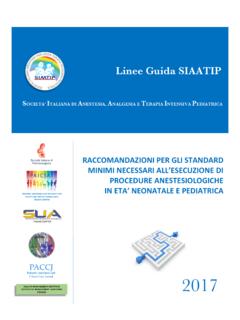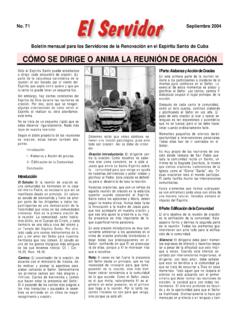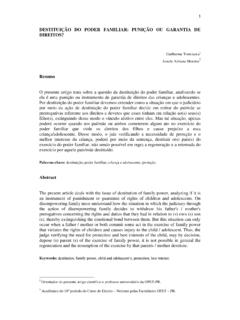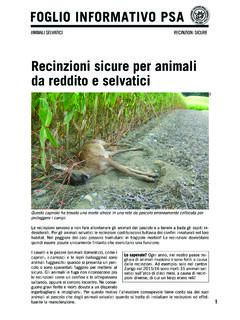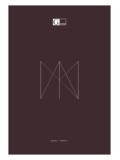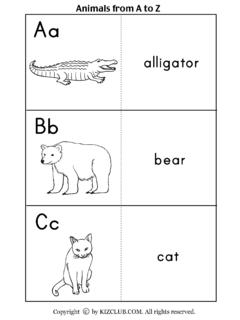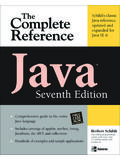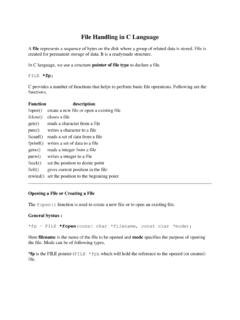Transcription of Considerations about anesthesia in patients suffering from ...
1 Pediatric anesthesia and Critical Care Journal 2013; 1(2):43-45. Considerations about anesthesia in patients suffering from myopathy G. de Francisci 1 , M. La Sala 1 , G. Addabbo 1 , P. De Santis 1 , D. Galante 2 , M. Caruselli 2. 1. Department of anesthesia adn Intensive Care, Catholic University of S acred Heart, Policlinic A. Gemelli , Rome, Italy 2. University Department of anesthesia and Intensive Care, University Hospital O spedali Riuniti, Foggia, Italy 3. Department of anesthesia and Intensive Care Salesi Children's Hospital, Ancona, Italy Corresponding author: G. De Francisci, 1 Department of anesthesia adn Intensive Care, Catholic University of Sacred Heart, Policlinic A. Gemelli , Rome, Italy. Email: Key points General anesthesia in myopathic patients poses several problems. The patient may be a child with initial symptoms, which must be subjected to muscle biopsy or a patient with overt myopathy, with all the events muscular, respiratory and cardiac related to it, to be submitted to any operation under general anesthesia .
2 Abstract shortening of the PQ, QT prolongation, especially in the Dystrophies are generally classified into progressive, advanced stages (1, 2). such as Duchenne, Becker, the Emery-Dreifuss, the - A respiratory evaluation should be performed because Central Core, the Nemaline, the King Denborough and many myopathies in advanced stages are accompanied congenital and mitochondrial myopathies, which can be by a respiratory failure so it will be necessary to make present at birth. General anesthesia in myopathic poses an assessment of respiratory status and the patient's several problems. The patient may be a child with initial ability to mobilize secretions. symptoms, which must be subjected to muscle biopsy or In relation to the risk of malignant hyperthermia with a patient with overt myopathy, with all the events volatile anesthetics, which still represents a topic of muscular, respiratory and cardiac related to it, to be discussion without unanimous agreement, we can say submitted to any operation under general anesthesia that in our opinion the risk is concrete with only two even if regional blocks are also possible.
3 For this reason, types of myopathy: the Central Core and the King- it becomes crucial an initial framework preoperative of Denborough. In the other myopathies, in particular in the myopathic patient. the Duchenne, the volatile anesthetics can cause Keywords: myopathy; general anesthesia . rhabdomyolysis-hyperkalaemia only for prolonged Anesthetic assessment exposure. Short-term exposure, such as the inhalational Based on our clinical experience consider necessary the induction, seems to be not a problem, even in our following assessment: experience. - in all myopathic patients should be carried out a Intraoperative management cardiologic examination; in many myopathies, in fact, it We believe, in the intraoperative management of the can be observed a preclinical cardiopathy or an overt myopathic patient, it must be kept in mind a few simple dilated cardiomyopathy, conduction disorders, concepts: de Francisci et al.
4 anesthesia and myopathy 43. Pediatric anesthesia and Critical Care Journal 2013; 1(2):43-45. the inhalational induction in children is not We finally point out that, based on these results, we contraindicated believe "excessive" a number of precautionary measures the dose of neuromuscular blocking agents has to be taken in the past such as: the operation as first on the reduced (3). list, the caffeine-halothane test and the wash-out of the in mitochondrial myopathies, prolonged exposure to anesthesia machine with oxygen. propofol can cause PRIS ("Propofol Infusion Syndrome"). Table 1. Examined patients suffering from myopathies succinylcholine is always controindicated, because of PATIENT ID AGE DIAGNOSIS. the risk of rhabdomyolysis-hyperkalemia, which can also be fatal (4). ZF 6 DUCHENNE. the prostigmine is not contraindicated, even in myotonia (5). UN 6 DUCHENNE.
5 In our recent study we evaluated a total number of 14. patients , including 10 with overt Duchenne dystrophy, MA 10 DUCHENNE. one affected by isolated hyper-CK-emia and 2 without defined diagnosis as described in Table 1. CE 8 DUCHENNE. Conclusions For all patients , our anesthetic management has DA 2 DUCHENNE. provided a monitoring system comprising: electrocardiogram, pulse oximetry, non-invasive SM 8 OTHER. MYOPATHY NMD. measurement of blood pressure, capnometry and the use of thermal blankets to prevent hypothermia. PG 2 IPER-CK-EMIA. Preoperatively we never gave premedication. In the intraoperative we always used an induction to LD 4 UNDEFINED. Sevoflorane with high MAC (7-8%) in combination DIAGNOSIS. with Alfentanyl g / kg; as we have always associated a low-dose non-depolarizing muscle relaxant: CE 9 DUCHENNE. the Rocuronium Bromide at dose of mg / kg.
6 For maintaining of anesthesia we never used halogenated PF 8 DUCHENNE. anesthetic vapors but exclusively Propofol in intravenous infusion or in refracted bolus, depending on BA 7 DUCHENNE. the duration of the operation, associated with an opioid (Alfentanyl, Fentanest). At the end of anesthesia we used the reversal of muscle MD 6 DUCHENNE. paralysis with neostigmine and patients were all awakened in the operating room. AO 9 UNDEFINED. With this approach, no case have shown postoperative DIAGNOSIS. complications, neither immediate nor after hours; vital GM 8 DUCHENNE. signs were stable and the body temperature normal. de Francisci et al. anesthesia and myopathy 44. Pediatric anesthesia and Critical Care Journal 2013; 1(2):43-45. References 1. Crean P, Hicks E. Essentials of neurology and neuromuscular disease. In Cot , Leiman, Todres: a practice of anesthesia for infants and children, 2009.
7 2. Jimenez N, Song K, Lynn A. Haemodinamic instability during prone spine surgery in a patient with muscular distrophy. Pediatric Anaesth. 2013;. 23: 294-296. 3. Muenster T et al. Rocuronium mg/Kg induces a normal peak effect but an altered time course of neuromuscular block in patients with Duchenne's muscular dystrophy. Pediatric anesthesia 2006;. 16:840-845. 4. Lavezzi W, Capocchione S, Muldoon S, et al.: Death in the emergency department: un unrecognized awake malignant hyperthermia-like reaction in a six year old. 2013;116:420-423. 5. Veyckemans F. Myotonic dystrophies 1 and 2: anestetic care. Pediatric anaesthesia 2013 (in press). de Francisci et al. anesthesia and myopathy 45.

